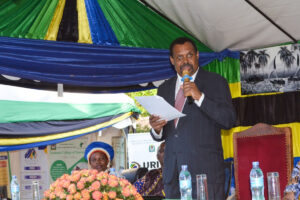
By Cecilia Otaru
One thing we can all agree on is the fact that we now live in an incredibly technologically driven and fast-paced world.
This is evident in how quickly the simple way of doing life is changing.
Living in a world that is technologically enabled, we now consume a wide range of services digitally and make payments in the same manner.
As simple as this sounds to end-users, the increasing irrelevance of physical presence for businesses to generate revenues presents an interesting challenge to tax policy makers and administrators globally.
It necessitates them to particularly assess whether the existing tax systems and laws are effective and inclusive enough to address all the relevant revenues and profits made in their respective jurisdictions.
In the context of international taxation, the digital economy has introduced the need for tax authorities to adopt a holistic approach in addressing base erosion and profit shifting by multinational enterprises (MNEs). This has led to the introduction of various unilateral measures globally, such as the digital services tax (income tax on “electronic services”) introduced in Tanzania in July 2022.
Further, together with unilateral measures adopted by various countries in the world, it is still perceived that an effective and inclusive tax system to adequately cover the digital economy would be one that adopts multilateral measures, whereby tax authorities and policy makers would come together and adopt a unified approach.
This is due to the nature of the digital economy itself, possessing a significant inherent risk for base erosion and profit shifting, that may render unilateral tax monitoring and administration measures taken by each jurisdiction to be incomprehensive.
Hence, acknowledging the need for policy makers and tax authorities globally to come together to address the taxation of the digitalized and globalized economy has led to the introduction of the Two-Pillar Solution. This is an initiative under the Organisation for Economic Co-operation and Development (OECD)/G20 Base Erosion and Profit Shifting (BEPS) Project aiming to create a single set of consensus-based international tax rules to address base erosion and profit shifting. The project targets to protect tax bases while offering increased certainty and predictability to taxpayers.
In summary, Pillar One through the introduction of Amount A, targets to reallocate certain amounts of taxable income to market jurisdictions. Market jurisdictions are countries from which foreign companies derive profits without having (under current rules) any taxable presence in such countries. Taxable income and profitability thresholds apply for this solution.
Pillar One also provides for a simplified and streamlined approach to the application of the arm’s length principle to in-country baseline marketing and distribution activities, with a particular focus on the needs of low-capacity countries. This is done through the introduction of Amount B.
Further, Pillar Two provides a coordinated global minimum tax regime seeking to ensure that Multinational Enterprises (MNEs) with a minimum of Euro 750 million global revenue per year are subjected to an effective tax at the rate of 15 percent on profits in the jurisdictions where they operate.
This solution introduces critical concepts such as Qualified Domestic Minimum Top-up Tax (QDMTT), Income Inclusion Rule (IIR) and Undertaxed Profits Rule (UTPR).
QDMTT acts as a top-up tax to bring the effective tax rate up to the agreed minimum of 15 percent. It calculates the excess profits of constituent entities and increases the domestic tax liability to the minimum tax rate. Implementing QDMTT, countries could claim the first right to tax profits currently being taxed below the effective rate of 15 percent.
It’s challenging to think that if a country such as Tanzania having a subsidiary whose parent company is in a jurisdiction that implements the QDMTT, providing a tax relief that renders the effective tax rate of the subsidiary to be lower than 15 percent does not provide the intended incentive to invest in the country, since the excess tax would be claimed in the parent company’s jurisdiction. Hence, due to the possibility of losing taxing rights to other jurisdictions, consideration for the application of a Domestic Minimum Top-up Tax is key at this point.
Also, IIR introduced under Pillar Two requires that if a foreign subsidiary is in a jurisdiction with a lower tax rate, the parent company must pay a top-up tax to bring the income up to the minimum tax rate. The UTPR acts in support of the IIR. on cases where the top-up tax is allocated under the IIR, the UTPR ensures that the remaining top-up tax is accounted for by the jurisdiction where the low-taxed constituent entities are located.
In my view, a 15 percent minimum effective rate will not restrict Illicit Financial Flows (IFFS) out of Africa through artificial profit-shifting strategies, as it is significantly lower than the statutory corporate income tax rates in Africa, which range between 25 percent and 35 percent. This disparity creates a substantial incentive to profit shift out of Africa which undermines the objective of the introduction of the Pillar Two solution.
However, despite reservations against the introduction of the Two-Pillar solutions by some countries in their tax systems and policies, implementation has begun for other countries in the globe. The European Union (EU) Minimum Tax Directive (2022/2023) entered into force on 23 December 2022 required the Member States to transpose the rules into domestic law by 31 December 2023. The Directive requires that IIR is implemented for fiscal years on or after 31 December 2023 for member states with more than 12 in-scope multinational groups. UTPR and QDMTT to be implemented for fiscal years beginning 31 December 2024.
Interestingly, these measures are designed to effectively address base erosion and profit shifting by being implemented multilaterally. Hence, their implementation in some jurisdiction is likely to have an impact on the jurisdictions that are yet to get on-board or do not plan to implement these solutions.
For Tanzania which is currently not a member of the OECD Inclusive Framework, this is a good opportunity to conduct practical impact analyses of these Two-Pillar solutions. This is particularly relevant considering that digital services tax is already in action, as a unilateral measure for targeting the digital economy.
Further, the Two-Pillar solution is anticipated to be a positive move towards solving and minimizing transfer pricing disputes across the globe. This is by establishing certainty in taxation and streamlining pricing of some globally uniform functions. It is also of great importance for the Revenue Authority to assess whether this benefit will be actualized in the Tanzania jurisdiction, considering the realities of the related party transactions commonly practised in the country.
Overall, in anticipation of the impact of the implementation of the Two-Pillar solution across the globe, an informed decision will need to be made on whether to retain the unilateral measures of taxing the digital economy or join forces with the members of the Inclusive Framework in implementing multilateral measures.
Cecilia Otaru ([email protected]) is a Manager at KPMG in Tanzania. The views expressed here are the author’s and do not necessarily represent the views and opinions of KPMG














